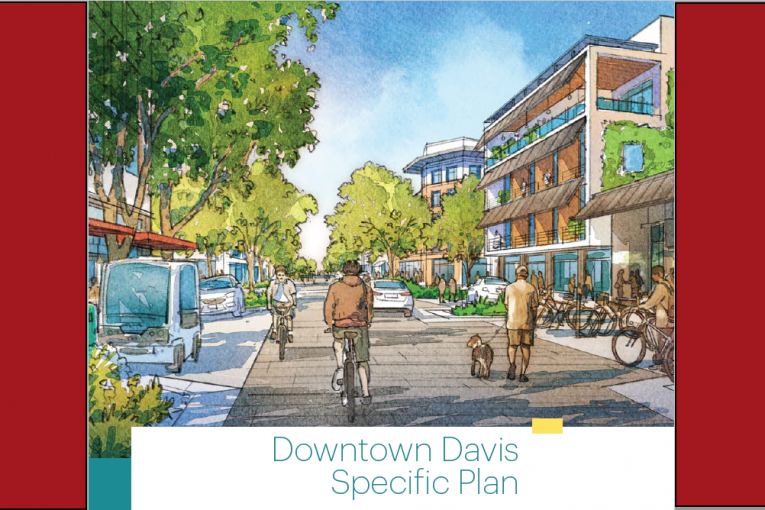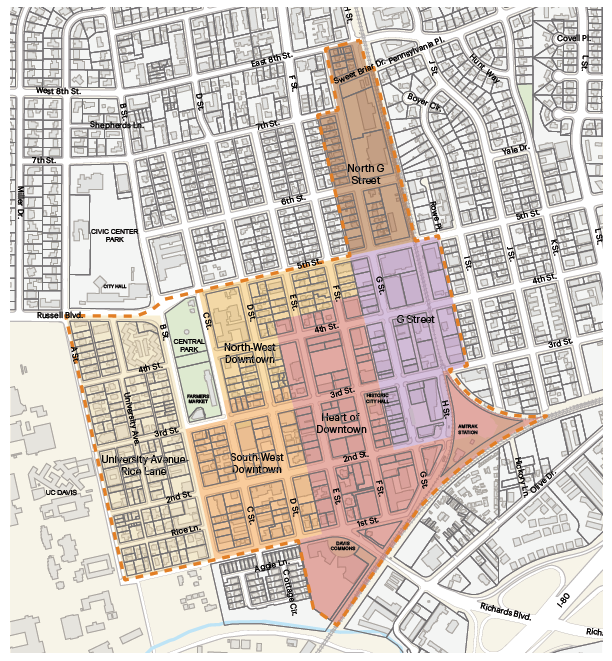

The City of Davis has released the Draft Davis Downtown Plan this week. Yesterday’s article (City Releases Draft of Downtown Plan and Code) looks at the six goals of the plan. This will look at the “design direction needed to fulfill the vision.
“A strategy of incremental growth and a series of coordinated design improvements will create a Downtown that reflects the community vision and serves as the heart of the City,” the plan notes.
“Downtown is physically constrained by the fact that it is largely built out and has few vacant parcels. However, there are redevelopment opportunities, including several large city-owned parking lots and underutilized bank sites in prime locations,” the plan continues.
However, there are economic challenges to this, as we have noted in previous articles.
“At present, it is economically challenging to develop in Downtown due to high land costs and a regulatory and entitlement process that is lengthy and uncertain,” the plan continues.
“The Specific Plan addresses these development challenges by recommending phased incremental growth as a development strategy, boosted by an entitlement process that provides clarity and  removes the existing layers of regulatory constraints on redevelopment so that investors and developers can focus on implementation rather than spending time and money to determine lot yields and capacity needed for project viability.”
removes the existing layers of regulatory constraints on redevelopment so that investors and developers can focus on implementation rather than spending time and money to determine lot yields and capacity needed for project viability.”
One approach will be to establish a design hierarchy of small, medium, and large. The small buildings will be one to two stories in height. The medium will be “detached transitional buildings,” typically two to four stories in height. The large footprint will be “attached block-form buildings” that are two to seven stories in height.
The plan notes that these will be as large as a city block “or collectively arranged along a street to form a continuous façade as long as most or all of a block. These environments include higher-intensity neighborhoods and main streets.”
The plan notes: “Buildings in these environments typically have minimal setbacks and are often mixed-use with ground floor nonresidential uses and housing or office on upper stories.”
Examples of buildings found here include townhouses attached to create a long front façade and mixed-use main street buildings.


The plan also calls for the designation of “special areas.” They have been identified due to their location, size and importance to the implementation of the overall vision.

Finally they identify the downtown as a collage of six distinct neighborhoods, “each with its unique qualities and character, that contribute to Downtown’s identity.”

Heart of Downtown – “Today: Downtown’s commercial core with inadequate hierarchy and public space. Tomorrow: An active, mixed-use destination with Davis Square as a central public gathering space.
G Street – “Today: Shopfronts and warehouse buildings adjacent to the freight rail corridor. Tomorrow: A dynamic neighborhood fostering innovation and entrepreneurship.”
North G Street – “Today: Residential area with small businesses along an aging retail center. Tomorrow: Vibrant node with mixed-use buildings and new neighborhood-scale public space.
South-West Downtown – “ Today: Active mixed-use area south of Central Park. Tomorrow: Cohesive mixed-use neighborhood connected to surrounding neighborhoods by enhanced bicycle and pedestrian corridors.”
North-West Downtown – “Today: Small-scale environment with residential, office, and some retail uses, near Central Park. Tomorrow: Sensitive infill reinforcing existing character and flexibility.”
University Avenue-Rice Lane – “Today: University-adjacent neighborhood with retail geared towards both residents and students. Tomorrow: Reinforced identity anchored by Third Street improvements.”
One of the big proposals is the transformation of the E Street Plaza into a public square. This would include pedestrian passages through the site from Second and Third Street, underground parking, publicly accessible courtyards, designing storefronts along the plaza, and shift massing.
They write: “One of the key placemaking moves and public space improvements recommended by the Specific Plan is the conversion of E Street Plaza into Davis Square to create a new central focus in Downtown, and encourage redevelopment of parcels around it.”
For G Street, “The G Street neighborhood is envisioned as a dynamic, flexible area that utilizes the industrial buildings and attracts innovators and artisans.”
They write, “In the future, the medium- and large-scale buildings can find new life as this area evolves as a ‘flex’ district. These scalable spaces, close to services and amenities, could support traditional commerce along with temporary retail; as well as makerspaces for artisans and creators, business incubators, start-ups, co-working spaces, and entrepreneurs focused on new technologies, research and innovation.”
For North G Street, “The North G Street neighborhood will be a residential and mixed-use area with an active public open space at its center.”
They write, “The current residential character will be respected and further enhanced by tactical infill development on the east side of G Street. The northern part will be gradually converted into a mixed-use center in coordination with the street improvements on G Street and a new public space. Galleries and terraces will create a welcoming environment for the new businesses in this mixed-use center.”
For North-West Downtown, it “provides the transition in scale and activity between the Heart of Downtown and Old North.”
They write: “Medium-scale buildings contribute to a walkable neighborhood environment. The neighborhood supports a range of housing options, from accessory dwelling units to cottage courts and multiplexes. Neighborhood retail and offices inhabit eclectic house-form buildings. Porches and stoop frontages add a welcoming character.”

For South-West Downtown, the neighborhood will be mixed-use, providing both employment and housing options.
They write: “The current mixed-use character of the neighborhood will further evolve as Second Street develops into a medium-scale main street environment and a priority bicycle corridor. Shopfronts, terraces, galleries, and arcades will contribute to a walkable urban environment.”
For University Avenue-Rice Lane: “The University Avenue-Rice Lane neighborhood will continue to be a residential neighborhood and benefit from the Third Street pedestrian and bicycle improvements.”
They write: “The character of this neighborhood will remain as low-intensity residential, with limited commercial uses on the edges of the neighborhood, and along Third Street. New development will occur as infill that respects the architectural scale and typologies of the neighborhood. The scale of the building will not exceed current precedents in the neighborhood. Additional height at the block corners along B Street can be encouraged to provide more character.”
—David M. Greenwald reporting


Urban planners seem to inhabit a world unfettered by marketplace realities and basic principles of private property ownership.
Particularly the latter, and most particularly with the loss of Redevelopment agencies… with the ability of eminent domain…
The aggregation of parcels to get the critical mass for sites, is going to be a Herculean feat. But, not impossible…
These ideas aren’t bad – often make great urban spaces in similar towns – impracticality is always a demon!
Agree on both counts.